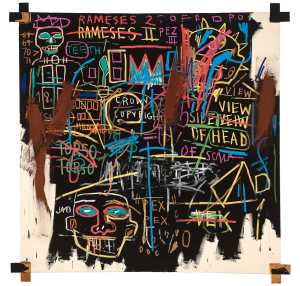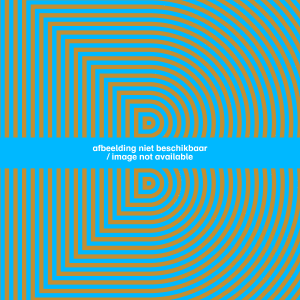The thing that interested the Belgian surrealist artist Magritte was the mystery that lay in everyday visible reality. He was not so much inspired by the invisible, the subconscious and dream images but rather by ordinary objects to which he gave a twist. The man Magritte portrays here is the eccentric wealthy Englishman Edward James. He was a friend of the artist and bought various works from him. In the 1930s Edward James was the benefactor of both Dalí and Magritte. Magritte based the portrait on a photograph he made of Edward James looking at the painting 'On the threshold of freedom'.

Specifications
| Title | La reproduction interdite |
|---|---|
| Material and technique | Oil on canvas |
| Object type |
Painting
> Painting
> Two-dimensional object
> Art object
|
| Location | This object is in storage |
| Dimensions |
Height 81 cm Width 65,5 cm Thickness 2 cm |
|---|---|
| Artists |
Painter:
René Magritte
|
| Accession number | 2939 (MK) |
| Credits | Purchased 1977 |
| Department | Modern Art |
| Acquisition date | 1977 |
| Creation date | in 1937 |
| Collector | Collector / Edward James |
| Provenance | Edward James, Chichester 1937-64; Edward James Foundation, Chichester 1964-77 |
| Exhibitions | London 1938; London 1969; London 1973a; Hamburg 1982; Humlebaek 1983; Düsseldorf 1996-97; Brussels 1998; Brighton 1998; Paris 2003; London/Rotterdam/Bilbao 2007-08; New York/Houston/Chicago 2013-14; Edinburgh/Hamburg/Rotterdam 2016-17 |
| Internal exhibitions |
Een prikkelcollectie (2000) The Collection Enriched (2011) Gek van surrealisme (2017) De collectie als tijdmachine (2017) Lievelingen (2024) |
| External exhibitions |
Magritte: The Mystery of the Ordinary 1926-1938 (2013) Surreal Encounters - Collecting the Marvellous (2016) Dalí, Ernst, Miró, Magritte... (2016) Dal nulla al sogno (2018) Surrealist Art - Masterpieces from Museum Boijmans Van Beuningen (2021) Dalí, Magritte, Man Ray and Surrealism. Highlights from Museum Boijmans Van Beuningen (2023) A Surreal Shock – Masterpieces from Museum Boijmans Van Beuningen (2021) A Surreal Shock. Masterpieces from Museum Boijmans Van Beuningen (2023) Magritte, Broodthaers & de hedendaagse kunst (2017) Only the Marvelous is Beautiful (2022) |
| Research |
Show research A dream collection - Surrealism in Museum Boijmans Van Beuningen |
| Literature | London 1973, p. 35, cat. no. 41; Sylvester 1992a, p. 244; Sylvester 1993a, p. 244, cat. no. 436; Caws 2004, p. 87; Rotterdam 2006, pp. 112, 118; Rotterdam 2007, pp. 110-11; London/Rotterdam/Bilbao 2007-08, pp. 276-77, cat. no. 13; New York/Houston/Chicago 2013-14, pp. 205-06, fig. 123; Edinburgh 2016, pp. 200, 215, 248, cat. no. 97 |
| Material | |
| Object | |
| Geographical origin | Belgium > Western Europe > Europe |
Entry catalogue A dream collection - Surrealism in Museum Boijmans Van Beuningen
Author: Marijke Peyser
From 12 February to 19 March 1937 Magritte stayed in London with the English collector and patron Edward James, where he worked on a triptych for the ballroom of James’s house in Wimpole Street (see Le modèle rouge III). During that stay the artist received two more commissions. James wanted to add a new version of Le monde poétique, a painting made in 1926, to his collection.[1] He had seen the work in the Young Belgian Artists exhibition staged in the London Gallery in January 1937.[2] The second commission concerned his portrait.[3] From correspondence between Magritte and his wife Georgette, it is clear that the artist wanted to paint the portrait on his return to Brussels from a photograph of James.[4] In mid-April James sent Magritte a number of photographs. It is almost certain that the photograph of James standing looking at the large canvas Au seuil de la liberté (1937), one of the three paintings intended for the ballroom, was the point of departure for the portrait.[5] When the commissions were finished Magritte wrote to James: ‘I think that you will be very happy with La reproduction interdite. I am extremely curious to hear what sort of impression it makes on you and also on Dalí (hasn’t he been in London for some time?).’[6]
In La reproduction interdite James stands in front of a mirror in his London house. The mirror hangs above one of the mantelpieces in the ballroom.[7] Instead of reflecting his face, however, this mirror shows the back of James’s head. This odd situation is reinforced by the correct reflection of the book that lies on the mantelpiece, a copy of the French edition of Edgar Allan Poe’s The Narrative of Arthur Gordon Pym of Nantucket (1838). The book represents a permitted reproduction, James a forbidden reproduction; and the mirror the embodiment of the irrational.[8] Like Poe’s only novel, in which he appears to tell a realistic story of a disastrous expedition to the Southern Ocean, but which turns out to be an intangible and fantastic tale, the young man appears to be realistic, but is not in any way.
This ‘portrait manqué’ – a portrait in which the sitter’s face is invisible – met with James’s approval: in November 1937 he asked Magritte’s permission to depict the work on the cover of Rich Man, Poor Man, Beggarman, Wop (1937) the book he was about to have published.[9] James published this volume of stories, poems and letters under the pseudonym Edward Selsey, so the choice of an unrecognisable portrait was an obvious one. The work has been reproduced countless times and now is one of the icons in the museum’s Surrealism collection.
Footnotes
[1] Sylvester 1993a, p. 243.
[2] Sylvester 1992b, p. 187: the canvas was loaned by E.L.T. Mesens for this exhibition.
[3] Sylvester 1993a, p. 248: during Magritte’s stay in London he and James discussed the possibilities of another portrait, Le principe du plaisir (1937), in which the figure’s head would be replaced by a brilliant light. According to Sylvester, it is not certain that it was to be a portrait of James.
[4] Ibid., p. 53, letter dated 10 March to Georgette Magritte.
[5] Ibid., p. 244.
[6] Ibid. letter dated 18 May 1937.
[7] New York/Houston/Chicago 2013-14, p. 205.
[8] Gassner in Rotterdam 2017, p. 173.
[9] Sylvester 1993a, p. 244, see also Grunenberg/Pih 2011, p. 141.
All about the artist
René Magritte
Lessen 1898 - Schaarbeek 1967
René Magritte studied at the academy in Brussels. He began as pattern designer in a carpet factory and as painter by painting and designing advertising posters...
Bekijk het volledige profiel
























